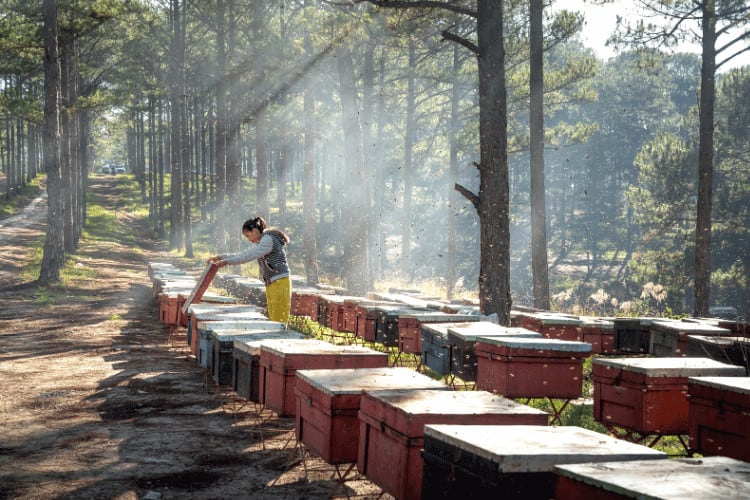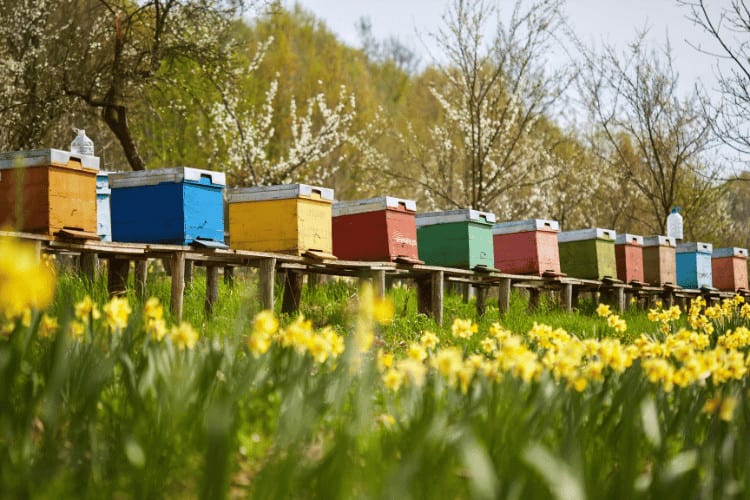How Many Bee Hives per Acre? Finding the Goldilocks Hive Density
Picture this: you’ve got a sweet piece of land, and you’re all hyped up about starting your beekeeping adventure. You’ve got the gear, the passion, and the visions of honey jars dancing in your head. But hold up a sec—how many bee hives per acre should you have?
I know what you’re thinking. There must be some magic formula that can spit out the perfect number. Well, not exactly. It’s more like a blend of science, experience, and a dash of common sense.
There are a lot of factors that go into establishing hives per acre. As a general rule, Bumble Bees can have one to two colonies per acre and Honey Bees are happy with two to four hives per acre.
In this article, I’ll discuss the factors that influence hive density, explore different bee species and their unique needs, and shed light on the risks of incorrect hive density. I’ll also provide practical hive management techniques to ensure you maintain the right bee density at all times.
Factors Influencing Hive Density

Determining the optimal number of bee hives per acre depends on various factors. As a beekeeper, you must carefully consider the interplay of these factors to strike a balance between maximizing honey production and ensuring colony health.
Here’s a close look at some of the key factors influencing hive density decisions:
Bee Species and Behavior
Think of bees like a bunch of roommates with different personalities.
You’ve got honeybees, the social butterflies that like to live it up in big colonies. Then there are solitary bees—the introverts of the bee world—that require more individual nesting space.
Oh, and watch out for those feisty bees that play territorial games. Certain bee species, such as the Africanized honeybee (often referred to as killer bees), are more responsive to disturbances, leading to potential issues with overcrowding.
As a beekeeper, you’ve got to factor in their personalities when deciding how cozy they can get.
Availability of Forage and Floral Resources
The abundance and diversity of forage and floral resources in the area significantly impact the number of hives that can be supported per acre.
A location with ample blooming plants provides bees with sufficient food sources, allowing higher hive densities.
In contrast, areas with limited forage may require lower hive densities to prevent resource competition and stress on colonies.
Local Climate and Environmental Conditions
Climate plays a vital role in bee activity and foraging.
Regions with longer foraging seasons, milder winters, and consistent floral resources can support higher hive densities.
Harsh weather conditions, such as extreme cold or excessive rain, may necessitate lower hive densities to ensure bee survival.
Hive Management Goals
What’s your beekeeping goal? Are you after barrels of honey like a bear with a sweet tooth, or are you all about helping out the ecosystem with pollination power?
Your goals shape the game: more hives for honey, fewer for happy, healthy bees. The objectives of a beekeeping operation heavily influence hive density decisions.
Type of Land
Urban jungle or countryside paradise? Your land type matters.
Urban environments with limited space require compact hive arrangements, potentially leading to higher hive densities.
Rural or agricultural areas could offer more expansive setups, allowing for greater flexibility in hive distribution.
Hive Spacing and Arrangement
Think bee feng shui.
If the hives are huddled too closely, it’s like a traffic jam—bees bumping into each other, stressing out, and passing around potential problems like a cold.
But if they’re too spread out, it’s like everyone’s on their own island; foraging becomes a hassle, and the bees’ chit-chat sessions are limited.
Finding that sweet spot in spacing allows bees to forage efficiently while minimizing negative impacts.
How Many Bee Hives Per Acre: Finding the Rough Estimates
Let’s cut to the chase: you want numbers, and I’ve got some ballpark figures for you.
Keep in mind that these are general guidelines, and your specific situation might sway the numbers one way or the other.
Here’s a sneak peek into what hive density might look like:
Honey Bees
For honeybees, you’re looking at around two to four hives per acre of land. This range gives each hive a decent chunk of space to thrive without elbowing each other out of the way at the local flower buffet.
If your area is abundant with blooms, you might want to lean toward the higher end. But if flowers are a bit scarce, sticking closer to two hives per acre might be wiser.
Solitary Bees
If you’re dabbling in solitary beekeeping, it’s a whole different game. These are the lone wolf bees that don’t live in colonies. They’re cool with a bit more personal space. You could have a bunch of solitary bee houses (those cute little bee “hotels”) on an acre without much fuss.
Bumblebees
Bumblebees are the big, fluffy bees that bring their A-game to pollination. These guys are known to need a bit more room to roam and gather nectar, so they appreciate a slightly lower hive density. You might want to stick to around one to two bumblebee colonies per acre.
Native Bees
Native bees come in all shapes and sizes, and their preferences can vary widely. Some might be content with a few nests per acre, while others might want a bit more elbow room.

If you’re venturing into native bee territory, it’s a good idea to do a bit of research on the specific species you’re dealing with and tailor your hive density accordingly.
Too Few or Too Many: The Dangers of Improper Hive Density
Incorrect hive density can be like trying to cram into an elevator with one too many people; it might work for a bit, but then things start to get messy. According to my research and personal experiences, these are the dangers of an incorrect hive density:
Resource Competition and Scarcity
Imagine entering a buffet with just a few crumbs left on the table; not exactly a satisfying dining experience. Bees face a similar challenge when hives are overpopulated on limited forage grounds.
The ensuing competition for nectar and pollen can compromise their nutritional intake and overall health.
Elevated Stress Levels
Stressed bees are more susceptible to health issues.
Overcrowded hives elevate stress levels among the bee population, potentially weakening their immune systems and rendering them more susceptible to diseases and pests.
Swarming Events
Bees are innately programmed to reproduce and expand their colonies.
If hive density becomes excessive, it can trigger swarming, a process wherein a portion of the colony, including the queen, departs to establish a new hive.
While this is a natural phenomenon, it can hinder honey production and disrupt beekeeping operations, affecting the honey crop.
Disease Propagation
In densely populated hives, diseases and parasites can spread more rapidly due to close proximity among bees.

An outbreak among a few individuals can escalate swiftly, jeopardizing the health of the entire colony and potentially requiring intensive intervention measures.
Diminished Honey Yield
Honey production is resource-intensive, requiring bees to expend significant energy.
In an environment of heightened competition for resources due to excessive hive density, bees may allocate less energy toward honey production, resulting in reduced yields.
Displacement of Native Pollinators
In the larger context of pollinator diversity, an overabundance of honeybees due to high hive density can overshadow native pollinators, such as solitary bees.
This could lead to ecological imbalances, as the role of native pollinators in supporting local ecosystems is marginalized.
Ecosystem Disruption
Bees play an integral role in pollination, influencing plant reproduction and, subsequently, ecosystem health. An unsustainable hive density can disturb this delicate balance, negatively impacting both flora and fauna that rely on pollination for their life cycles.
Hive Management Techniques for Optimal Bee Density
Maintaining the appropriate bee density within an apiary is a critical aspect of successful beekeeping. It involves finding the balance between colony health, resource availability, and the overall well-being of the ecosystem.
Here are several hive management techniques that you should employ to ensure you have the right bee density at all times:
- Regular Hive Inspections and Monitoring: By closely monitoring hive dynamics, backyard beekeepers can identify signs of overcrowding or underpopulation, enabling timely interventions.
- Queen Management: Beekeepers can manage bee density by monitoring the queen’s performance. If the colony is growing too rapidly, you might want to split the colony or replace the queen. If the population is dwindling, steps can be taken to requeen or merge colonies.
- Hive Arrangement and Spacing: Efficient hive arrangement and proper spacing are crucial for maintaining optimal bee density. Adequate spacing allows bees to forage without hindrance, supports efficient hive inspections, and minimizes the risk of overcrowding.
- Environmental Considerations: Planting diverse flowering plants and minimizing the use of pesticides encourages a healthy foraging habitat. This approach supports higher bee populations by providing ample food sources and mitigating resource limitations.
- Adapting to Seasonal Changes: Hive numbers must be adjusted in response to shifts in flower availability, weather conditions, and bee activity. This adaptive approach ensures that colonies always have adequate space and resources to thrive.
Wrapping Up
Determining how many acres of land you need per hive involves several factors, including bee species, available forage, climate, hive management goals, and environmental conditions.
For honeybees, a common range is around two to four hives per acre. Solitary bees can be more flexible due to their individual nesting habits.
Bumblebees typically require one to two colonies per acre to accommodate their larger size and foraging needs, while native bees have varying preferences due to their diverse range of species and sizes.
Ultimately, the right hive density strikes a balance between bee health, resource availability, and ecosystem sustainability.
